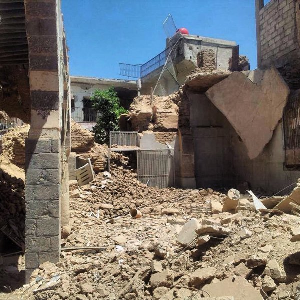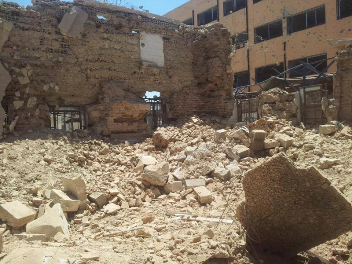
News

Syria’s oldest shul destroyed by Assad
ANT KATZ
Syrian Arab Army forces flattened the Eliyahu Hanabi Shul in the Jobar neighbourhood of Damascus last weekend according to an article published on NEWSWEEK’S DAILY BEAST. The attack not only wrecked a site that is at least 400 years old, it may also have destroyed thousands of irreplaceable Jewish artefacts contained inside the shul.
Exclusive photos obtained by Newsweek at the site show utter devastation.
 The area where the shul once stood has been under bombardment by the forces of Syrian President Bashar al-Assad for months. The Syrian regime is laying siege to the town, one of the few rebel strongholds in the area. It’s all part of what the opposition calls Assad’s “scorched earth” policy, which includes random and violent attacks on civilian populations, says newsweek.
The area where the shul once stood has been under bombardment by the forces of Syrian President Bashar al-Assad for months. The Syrian regime is laying siege to the town, one of the few rebel strongholds in the area. It’s all part of what the opposition calls Assad’s “scorched earth” policy, which includes random and violent attacks on civilian populations, says newsweek.
“I am deeply saddened to learn of the destruction of Jobar Synagogue, which was a treasure of Jewish and Syrian cultural heritage,” said Shlomo Bolts, an official at the Syrian American Council, an American charity connected to the Syrian opposition.
The Jobar Shul in Damascus lay in ruins on Monday after being shelled by Syrian government forces as can be seen in the photos on this page which were obtained exclusively by The Daily Beast, Newsweek’s website.
Jews latest victims of Assad’s strategy
Bolts, a Jew of Syrian ancestry, said the Syrian Jewish community was only the latest victim of Assad’s strategy to target religious and cultural institutions.
 “Yet this is hardly the only place of worship to be destroyed by the Assad regime. The Umm al-Zinar Church https://www.sajr.co.za/images/default-source/places/world/jobar-home.png” alt=”Jobar” title=”Jobar” />Activists estimate that at least 33 churches and hundreds of mosques have been destroyed by the Assad regime since the start of the Syrian civil war. Six Unesco World Heritage Sites in Syria have been destroyed in Syria since the fighting began.
“Yet this is hardly the only place of worship to be destroyed by the Assad regime. The Umm al-Zinar Church https://www.sajr.co.za/images/default-source/places/world/jobar-home.png” alt=”Jobar” title=”Jobar” />Activists estimate that at least 33 churches and hundreds of mosques have been destroyed by the Assad regime since the start of the Syrian civil war. Six Unesco World Heritage Sites in Syria have been destroyed in Syria since the fighting began.
Last December, photos emerged in another Israeli news report showing that many of the shul’s most precious artefacts were intact. The report stated that the bulk of the artefact collection was being held safely in the hands of local leaders.
Before the conflict, the shul held thousands of religious and cultural treasures, including hundreds-of-years-old Torah scrolls, historical texts, precious dining ware, and ancient Judaica of all sorts.
Some of the items were reportedly looted in the early days of the war. Some were reportedly placed in safekeeping. Many remained in the building until its destruction.
Opposition sources feared that all of the Jewish heritage items that remained inside the Shul are feared lost.
The history of the shul
The Eliyahu Hanabi Shul, built to honour the Prophet Elijah, had existed at least since mediaeval times. The site has been a destination for Jewish pilgrimage for centuries. It was said to have been built atop the cave where Elijah hid from his persecutors. The Prophet Elisha, who allegedly built the shul, was said to have anointed King Hazael on its steps, now gone.
The town of Jobar was home to a significant Jewish population throughout the mediaeval period, although the community was eventually driven out of Syria and the shul was taken over in the 19th century by local Arab leaders.
Following the establishment of the State of Israel, the shul was used as a school for displaced Palestinians.




